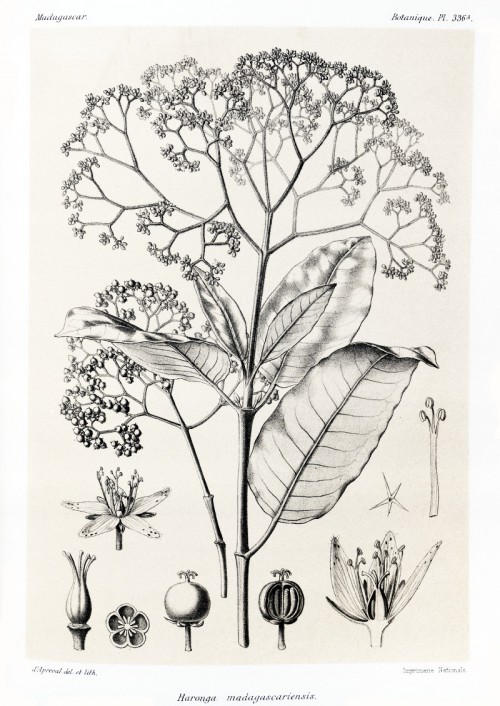Harungana madagascariensis Lam. ex Poir. - syn. Arungana paniculata Pers.; Haronga madagascariensis (Lam. ex Poir.) Choisy; Haronga paniculata (Pers.) Lodd. ex Steud. - Hypericaceae
haronga, orange-milk tree, praying hands, Haronga
Evergreen shrub or tree, up to 12m high, native to southern Africa (Sudan to South Africa, Madagascar); bark brown, rough, with orange or blood-red sap when damaged; leaves opposite, lanceolate-ovate to elliptic, up to 20cm long, dark shiny green above, densely covered in rusty hairs below; young leaves at stem apex flattened together hence the common name „praying hands“; inflorescence a large many-flowered corymbose-cymose panicle; flowers creamy-white, with glandular dots near the apex, sweetly scented; fruit a spherical drupe, 4mm in diam., yellow or orange when ripe.
http://www.zimbabweflora.co.zw/speciesdata/species.php?species_id=140420
http://plants.jstor.org/compilation/Harungana.madagascariensis
Hydroxylated anthracene derivatives like harunganin, harongin anthrone and 1,7-dihydroxyxanthone were isolated from the stem bark.
[Phytochimie de la tige de Harungana madagascariensis., Nguyen V.T., Debenedetti S., DeKimpe N.,Tetrahedron Lett (44), 2003, 41-99]
Haronga bark and leaves (Harunganae madagascariensis cortex et folium) are mainly used traditionally to treat stomach ailments like dyspepsia, and mild pancreatic insuffiency, and to stimulate the production of gastric juices and bile. „In African countries the reddish sap obtained from the bark is used as a styptic and is applied topically to treat various skin diseases, wounds, leprosy and itch… Studies have shown that bark and leaf extracts are choleretic and cholekinetic. Furthermore, the drug stimulates secretion of digestive juices from both the pancreas and the stomach.“
[Medicinal Plants of the World. Ben-Erik Van Wyk and Michael Wink, Pretoria 2004, 166]
The hydroethanolic (50%) and methanolic extracts of the stem bark contain mainly phenolics (65.7/52.5%). Tannin content was 7.2/3.5%, anthraquinonenes 0.5/0.4%, and alkaloids 2.4/06%.
[Quantitative Phytochemical Evaluation of Stem Bark Extracts of Harungana madagascariensis., Eze, F.N., Airouyuwa, O.J., Benin, B.C., British Journal of Pharmaceutical Research, 4(17), 2014, 2068-2074] http://www.sdiarticle1.org/prh/BJPR_14/2014/Revised-manuscript_version2_9988.pdf

Grandidier, A., Histoire physique, naturelle et politique de Madagascar, Atlas, vol.3 t.336A (1890) [d’Apreval]
http://plantgenera.org/species.php?id_species=494766